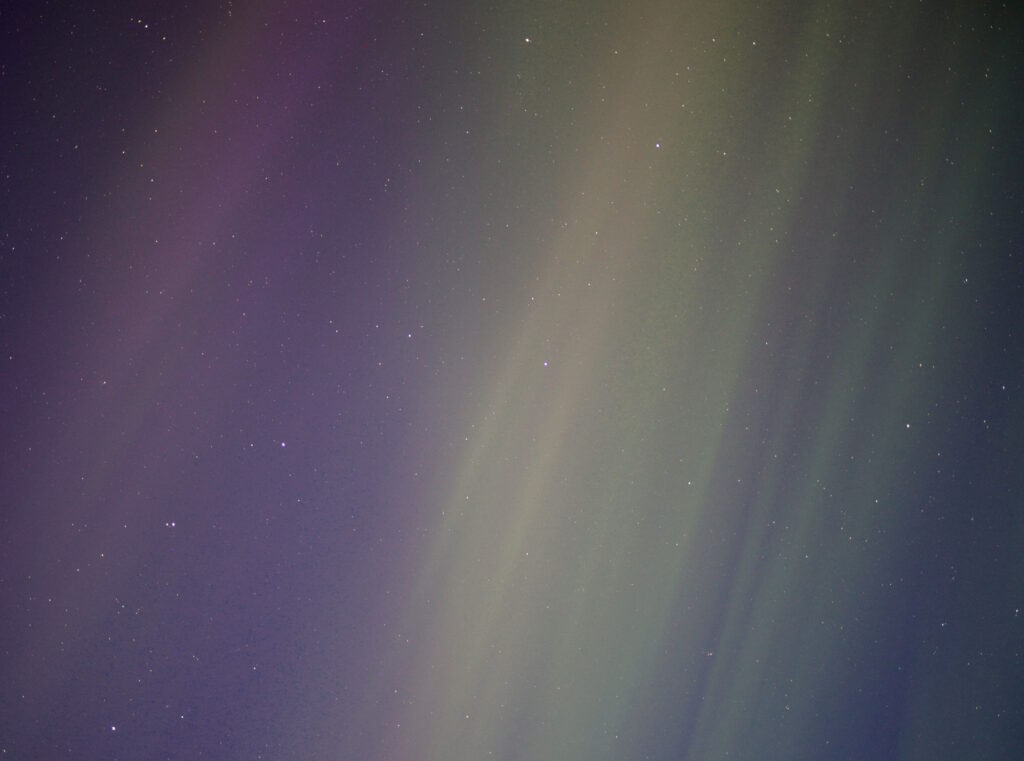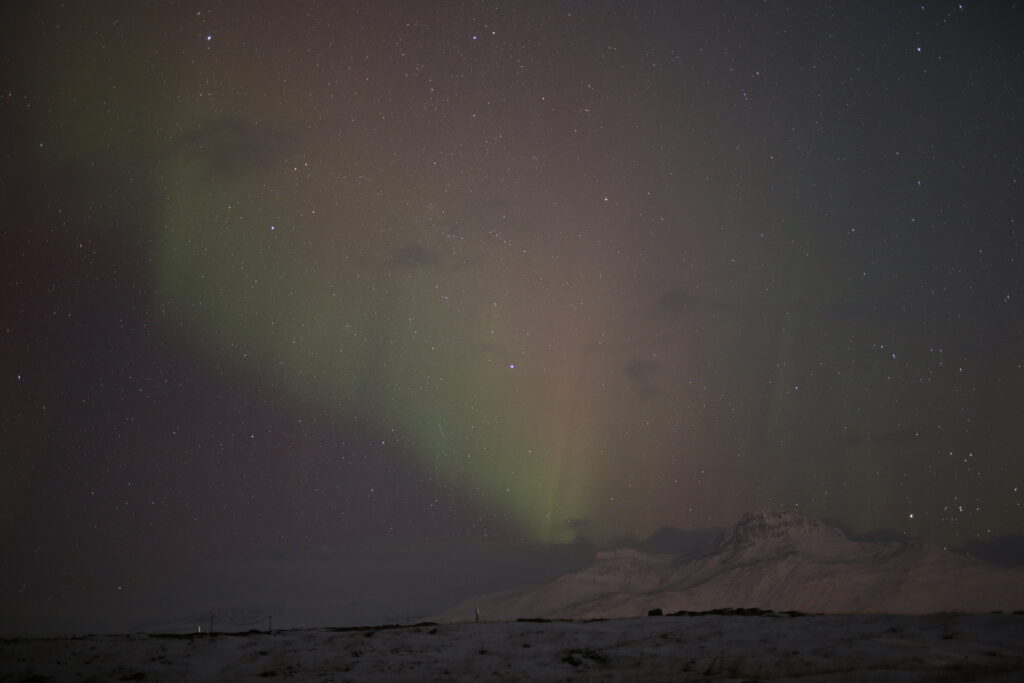Report on a trip to Iceland from October 10th to 17th, 2023
Dr. Gerold Holtkamp, October 19, 2023
The report describes what has to be taken into account for successful sightings of the northern lights. In addition, factors that cannot be influenced, such as the weather and the space weather, are also mentioned. Recordings and videos of the northern lights are shown. In addition, numerous sources are listed for more detailed information.
If you want to see the Northern Lights - also known as the Polar Lights or Aurora Borealis - you have to, as the name suggests, travel near the Arctic Circle. Various countries are good destinations here. On my very first trip to see the Northern Lights at the beginning of 2013, which I took alone, my destination was Tromsoe in Norway, which is even north of the Arctic Circle. I had successful sightings despite all the snow that fell from the sky in large quantities at least once every day and night. On my trip this year - this time with an old college friend - the destination was Iceland. Of course, Iceland is not only great as a place to observe the northern lights, it also has a lot of impressive untouched wild nature to offer. This report now focuses on what is worth seeing in the sky over Iceland. The natural beauties are reserved for other reports.

On the way
In my opinion, traveling to Iceland is easier than to the Scandinavian countries. The island can be easily reached from Germany by flight, which takes around three hours. The starting airport was Hamburg. The travel date was close enough to the equinox. At this time, the probability of the Northern Lights to occur is statistically highest for reasons that are not yet fully understood. We also scheduled the trip around the time of the new moon. The moon would have severely disrupted the observation of the northern lights. After arriving at Iceland's international airport near Keflavik, we drove north with the rental car (you need it there) to the small village of Skagaströnd. We were hoping that the weather there would be better and the cloud cover would be less than in the area around Reykjavik, where the influence of the Gulf Stream is much stronger than in the north. The Gulf Stream, with its warm water, causes higher temperature and humidity, especially on the western side of Iceland, than would be expected so close to the Arctic Circle.
But who doesn’t know the saying “To misfortune came bad luck?” It can be applied very well to this trip. However, “A coincidence of luck and fate” would fit just as well. Why both were possible will become clear below.
In search
Compared to my first trip to see the Northern Lights, this time we had much better information options to find out about the possible occurrence of the Northern Lights and to estimate the weather and road conditions [1][2][3]. So every day we mainly studied the long, medium and short term forecasts of both the weather in Iceland and the space weather. It did not help. Until October 13th, three nights passed under an impenetrable cloud cover. Our only consolation was that the solar wind, which is the decisive cause of the northern lights, was far too weak to produce any significant luminous phenomena [4][5][6]. If the sky was clear we wouldn't have seen anything. A small consolation...
But then in the early morning of October 13th - although it was already getting dim - we were lucky. There were gaps in the clouds and some northern lights could be seen. But the coming daylight quickly gained the upper hand over the faint glow in the sky and it was over. But at least it was a Northern Lights sighting.

2013-10-13, 6:41 UTC, Canon 6D, 50mm, 4s, ISO1600, f1.4

2023-10-13, 6:44 UTC, Canon 6D, 50mm, 4s, ISO1600, f1.4
The dance of the northern lights
A kind of “April weather” prevailed throughout the day. Short snow showers (it was getting noticeably colder) alternated with bright sunshine.

Towards the evening, a reasonably clear strip with few clouds stabilized in the sky over Skagaströnd, so that after sunset, when the darkness came, we set up our photographic equipment.

The impatient waiting began. What came was a snow shower that immediately drove us back to our accommodation. But then it remained clear. In the sky, a narrow, very faint strip of Northern Light appeared, barely brighter than the Milky Way. Its arc stretched relatively undisturbed from east to west.
Then around 11 p.m. it happened: The strip became brighter, much brighter than the Milky Way, became more structured, started moving and formed the typical Northern Lights shapes that are reminiscent of moving curtains. More lights appeared, grew brighter, moved. We had been working towards that. This is live experience!

2013-10-13, 21:45 UTC, Canon 6D, 50mm, 5s, ISO1600, f1.4

2013-10-13, 22:31 UTC, Canon 6D, 14mm, 25s, ISO1600, f2.8, Ausschnitt

2023-10-13, 23:14 UTC, Panasonic DMC-FZ1000, 90mm, 20s, f2.8
Picture taken by Dr. Michael Felsman

2023-10-13, 23:18 UTC, Canon 6D, 14mm, 30s, ISO1600, f2.8
2023-10-13, around 22:30 UTC, Canon 6D, 14mm, 25s, ISO1600, f2.8, crop
2023-10-13, gegen 23:00 UTC, Canon 6D, 50mm 2.5s f1.4 Blick NO 6fps
It wasn't until late around 1 a.m. that the northern lights became weaker. In addition, the clouds took over again. Satisfied, we retreated to our accommodation from the now -8° C cold night.
________________________________________________________________________________________________________
[1] There are various sites on the Internet that help you “hunt” for the northern lights. For space weather:
- The so-called Notification Timeline is well suited for a medium-term (2-3 days) forecast https://www.swpc.noaa.gov/products/notifications-timeline . Here, predictions of the so-called Kp index are displayed with a green bar. The actual observations are marked with yellow bars. The history of the last 7 days is also displayed.
- Another page with predictions is http://auroraforecast.gi.alaska.edu/?area=Europe&date=20180305 , which in my experience is usually a bit too optimistic.
- For a short-term (approx. 1 hour) forecast there is https://www.spaceweather.com/ . Here you can, so to speak, fine-tune the other predictions.
- The best way to assess the current situation in the sky is to look up and enjoy the hopefully bright northern lights. Unfortunately, dense cloud cover often prevents you from doing so. So that you still know what is happening higher up and whether it is worth holding out to wait for gaps in the clouds, the magnetic field measurements from http://flux.phys.uit.no/Last24/ are very helpful. Disturbances in the earth's magnetic field caused by the impact of the solar wind are directly linked to the northern lights and are therefore a good measure for registering the luminous phenomena.
[2] In addition to space weather with its solar wind and solar storms, the weather at the observation site itself - or when searching for a suitable one - is of course also a very determining factor. For a forecast of cloud cover or precipitation, the following should be mentioned:
- https://www.meteoblue.com/en/weather/maps/iceland_iceland_2629691#map=cloudsAndPrecipitation~hourly~auto~sfc~none&coords=3.34/68.5/-5.4
- https://www.wetteronline.de/wetter/borgarnes
[3] In the winter months it is advisable to have good information about road conditions. You shouldn't want to drive through a pass road that's completely covered in snow, especially early in the morning. Here is very helpful: https://vegasja.vegagerdin.is/eng/
There are webcams installed in many places on the most important roads, which give you a good impression of the current road condition. Many also display the air and road temperature and wind speed.
[4] A general introduction to the physics of the northern lights can be found on the website Sonnen-Sturm.Info. This is also about predicting the occurrence of northern lights, especially in Germany.
[5] Anyone who is interested in the physics of the northern lights in detail should take a look here: Physics of the Upper Polar Atmosphere, Asgeir Brekke, Second Edition 2013, Springer, ISBN 978-3-642-27400-8
[6] Further detailed and partly very current information on the entire area of interaction between the sun and interplanetary space, which also includes the formation of the northern lights, can be found in the lectures at the so-called summer schools of the Heliophysics Project UCAR (University Corporation for Atmospheric Research) und der NASA: https://heliophysics.ucar.edu/resources-by-year